Vol 1 No. 18 TROPIC LIGHTNING NEWS July 1, 1966
Index
[The 1966 Vietnam issues of Tropic Lightning News were published in Saigon,
and are of lower quality than later years that were printed in Japan. Over
the years the photographs and text have faded and it has been difficult to
reproduce them. Even when the photos are unclear, I have been included
them to give a sense of the activities in the Division.]
From CinCUSARPAC
Organized in peace to help preserve the Free World, the United States Army,
Pacific, (is) nine years old (today). Little did we know then that today we
would once more be locked in an awesome struggle with the forces that constantly
strive to destroy our way of life.
Once again the enemy is on the move, and the very principles of liberty in
Southeast Asia hang in the balance. Men of the United States Army, Pacific,
along with those of the other services and allied countries, are encountering
the enemy in their own ground with superb performance and magnificent courage.
Their feats will be recorded as another chapter in the history of freedom.
To the men and women - military and civilian - of this vital command, I
extend my best wishes on this anniversary.
Because of your diligent and successful efforts to achieve combat readiness -
your knowledge, competence, loyalty and integrity - those who seek to destroy us
are being deterred.
Last year, at this time, I said that the members of the United States Army,
Pacific, would stand prepared and ready for whatever challenge the future held.
It is with pride that I note that you are meeting the challenge, and, I am
confident, you will continue to do so.
JOHN K. WATERS
General, USA
Commander-in-Chief, USARPAC
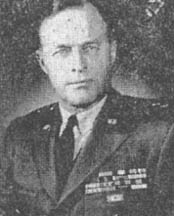 |
|
General John K. Waters |
U.S. Army, Pacific (USARPAC), the largest army command in the world,
celebrates its birthday today nine years after it was born. July 1, 1957,
USARPAC, Commanded by Gen. John K. Waters, is responsible for all the land
areas in a 12 million square-mile area. Virtually the entire Pacific Ocean
falls into the protective sphere offered by the command.
Ringing Communist China and Burma, USARPAC includes more than one billion
people, or about one third of the world's population. The command, while
officially only eight years old as it is now formed, had its origins in the
early part of this century with the Hawaiian Department, which was discontinued
in 1943. During World War II a series of commands was organized and later
consolidated to direct air, sea and land operations in the Pacific Theater.
In April 1945, General of the Army Douglas MacArthur was named commander of
the U. S. Army Forces in the Pacific. In a command which was unified with U. S.
Army Forces, Far East, and U. S. Army Forces, Pacific Ocean Area, Headquarters
USARPAC, was designated as headquarters for the Pacific area, except for General
MacArthur's command, which had been redesignated Far East Command (FEC). FEC
became U. S. Army Forces, Far East, in 1952 and the two commands worked separately until the present organization
was established in 1957.
In its sprawling area of responsibility, USARPAC is headquarters for Eighth
U. S. Army, I Army Corps, 2nd Infantry Division and 7th Infantry Division in
Korea; U.S. Army, Ryukyu Islands, IX Army Corps are in Okinawa; while U.S. Army,
Japan, maintains a small garrison force of about 3,000 men.
At USARPAC's Hawaii home, USARHAW is charged with operating National Guard
and Army Reserve units as well as the Army port and Pohakuloa Training Area.
Tripler Army Medical Center comes under the direct operation of USARPAC.
U.S. Military Assistance Command, Vietnam, including U.S, Army, Vietnam (USARV),
7th Air Force, U.S. Naval Forces, Vietnam, and 3rd Marine Amphibious Force, come
under the direct control of USARPAC and Commander-in-chief, Pacific, also
headquartered in Hawaii.
Currently included in USARV's control are 1st Infantry Division; 1st Cavalry
Division; 1st Logistics Command; 25th Infantry Division; 1st Brigade, 101st
Airborne Division; 173rd Airborne Brigade (Separate) and various separate
commands.
|
Transition at 3rd Brigade |
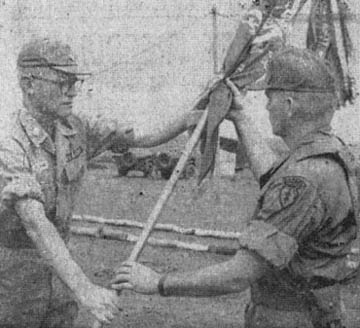 |
| EXCHANGE - Lieutenant Colonel Robert C. Kingston (right) accepts the colors of the 1st Battalion, 35th Infantry, from Lieutenant Colonel Edward F. Callanan in change of command ceremonies held at 3rd Brigade last week. Colonel Callanan will be the new brigade executive officer. (Photo by Martens) |
COL KINGSTON TAKES COLORS OF 1/35TH INF.
Lieutenant Colonel Robert C. Kingston, of North Easton, Mass., assumed
command of the 1st Battalion, 35th Infantry "Cacti Green" in change-of-command
ceremonies at Pleiku.
The battalion heard outgoing commander Lieutenant Colonel Edward F. Callanan
of Middletown, N.Y., express his appreciation for the hard work and loyal
support of the battalion.
After accepting the battalion colors, Col. Kingston stated it was a privilege
and a pleasure to accept command of the "Cacti Green." He said the battalion
would continue the job and to react to the ever-changing situations.
Col. Callanan has become the 3rd Brigade executive officer.
'Fort Smith' Nabs Ten
Second Battalion, 14th Infantry, has reported capturing ten Viet Cong as the
"Golden Dragons" moved into the fourth week of Operation "Fort Smith," near Ap
An Binh.
"Fort Smith," a project of area pacification and civic action as well as
search-and-clear missions, is a joint operation with division forces, Military
Assistance Command, Vietnam, advisers from Trang Bang and Army, Republic of
Vietnam (ARVN), civic action workers.
Enemy contact has remained light throughout the operation, although 2/14th
units on civic action and clearing missions have received automatic weapons and
machine-gun fire recently.
Advancing troops have found a number of houses abandoned as villagers leave
their breakfast rice, hide their valuables and disappear before the Americans
have arrived.
Occasionally a house is found where the people have remained. It is in those
homes that Vietnamese police, accompanying the battalion, question the
inhabitants on enemy movement in the area.
Battalion elements have discovered Claymore and anti-tank mines and have
destroyed numerous tunnels, including one more than 1,200 feet long. Also found
were several tons of rice, which was destroyed, and 600 coins, which have been turned over to
intelligence officials. (See photos pages 4 and 5.)
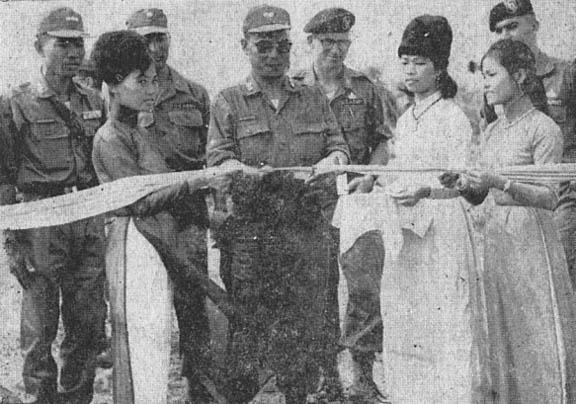 |
| SNIP - Tay Ninh Province Chief, Lieutenant Colonel Ho Duc Trung (center), cuts the ribbon opening the road into Ben Vang, first "New Life Hamlet" in Khiem Hanh District. (Photo by Hanson) (See story - Page 6). |
Page 2 TROPIC LIGHTNING NEWS July 1, 1966
Decorated
| DISTINGUISHED FLYING CROSS | |
| Maj. Michael J. Kubas, HHC, 1st Bde. | |
| BRONZE STAR MEDAL (Posthumously) |
|
|
PFC Donald Allaway, HHC, 4th Bn., 9th Inf. PFC David L. Arnold, Co. A, 1st Bn., 27th Inf. Sp4 James T. Benton, Co. C, 1st Bn., 5th Inf. PFC George A. Brown, C Co, 2nd Bn., 27th Inf. Sp4, George S. Franklin, Co. A, 1st Bn., 5th Inf. Sp4 Damion R. Hilts, Co. B. 1st Bn., 27th Inf. PFC Alvin Hoskins, Co. C, 1st Bn., 27th Inf. PFC James E_ Johnson, Co. B., 4th Bn., 23rd Inf. Sp4 Irvin D. Knippelberg, Co. C, 4th Bn., 23rd Inf. |
PFC Joseph R. Landry, Co. C, 2d Bn., 27th Inf. Sp4 John Parnella, Co. C, 1st Bn., 5th Inf. PFC Terry Reed, 25th Admin. Co. PFC Steven M. Smith, Co. B, 1st Bn., 5th Inf. SSgt Grover R. Taylor, Co. A, 1st Bn., 27th Inf. Sgt. Jimmy B. Taylor, Co. C, 1st Bn., 5th Inf. PFC Lewis M. Thomas, Co. A, 1st Bn., 5th Inf. PFC Walter J. Typer, Co. B., 1st Bn., 5th Inf. Sgt. Roy D. Watts, Co. A, 1st Bn., 27th Inf. |
| AIR MEDAL |
|
|
Capt. Billy Doozy, Co. A, 25th Avn. Bn. Capt. Garrett A. Easley, Co. A, 25th Avn. Bn. Capt. Harris Flanagin, Co. B, 25th Avn. Bn. Capt. Ira L. Hartwell, Co. A, 25th Avn. Bn. Capt. James B. Kelly, Co. A, 25th Avn. Bn. |
Capt. Delmar H. Livengood, Co. A, 25th Avn. Bn. Capt. Gary T. Meagher Co. A, 25th Avn. Bn. Capt. Danny L. Romig, Co.A, 25th Avn. Bn. Maj Hughey L. Weston, 25th Avn. Bn. |
| ARMY COMMENDATION MEDAL |
|
|
Sp5 John H. Cram, 25th Admin Co. Sp5 Daniel R. Parker, HH and S Btry., 1st Bn., 8th Arty. Sp5 Jerry Powell Jr., Co. A, 4th Bn., 9th Inf. |
SSgt Wilber Marshall, Co. C, 65th Engr. Bn. Sgt. Charles F. Rowland, Co. B, 1st Bn., 27th Inf. Sp5 Larry J. Wence, 25th Admin. Co. |
| PURPLE HEART |
|
|
Sp4 Leonard F. Barney, HHC, 2nd Bn., 27th Inf. Sgt Grady L. Career, C. Btry, 7th Bn., 11th Arty. SSgt William B. Cunningham, HHC, 4th Bn., 9th Inf. Sp4 Ernest Dawson, Co. A, 2nd Bn., 27th Inf. |
Sp4 Antonio M Gonzales Jr., Co. B, 1st Bn., 9th Inf. PFC Jerry T. Jodrey, HHC, 4th Bn., 9th Inf. Capt. John A. Renner, Co. A, 1st Bn., 5th Inf. PFC Terry L. Roaden, Co. A, 2d Bn., Inf. |
VC Army Hidden In NLF
(Editor's Note: This is the second of two articles concerning the
organization of the Viet Cong in South Vietnam. It deals with the military
apparatus.)
The military arm of the Viet Cong is completely integrated into the National
Liberation Front structure from the very top to the lowest level, with military
representatives found at all organizational levels of the Front.
Since the Vietnamese communists consider the war in South Vietnam to be
primarily a political struggle, the chief duty of the Viet Cong military forces
is to support the political aggression being conducted by the communists in the
name of the National Movement to Liberate South Vietnam.
A 64-page Front indoctrination booklet on the organization of its armed
forces declared that organization must perform to political lines; that the
Liberation Army is a fighting army and, therefore, must be highly centralized
with inferiors obeying superiors there must be discipline; and that the army's
political tasks are fundamental: maintaining unity between cadres and men, and
between the army and the people.
The booklet pointed out that these three principles insure that military
action is subordinated to political action, that the army is united and that the
people are closely united with the army.
The Viet Cong, the so-called Liberation Army in South Vietnam, is about one
half of the total communist armed forces in all Vietnam. The other half
comprises North Vietnam's People's Army of Vietnam, or the North Vietnamese
Army.
The Viet Cong forces consist of two basic elements: the paramilitary and the
full military. The paramilitary VC is generally a local civilian who is a
part-time soldier or guerrilla, whose military duties do not take him far from
his community. In addition, he is not highly indoctrinated politically.
At the hamlet level, the Guerrilla Popular Army is either a cell or a
half-squad - 3, 6 Or 12 men. The GPA unit at the village level (a village
consists of several hamlets) is the platoon, made up of three or four squads -
36 to 48 men. There are two, basic classes of GPA members. The first is the
village guerrilla, frequently an older man, generally used as a village
defender. He has little training and is armed with scanty or primitive weapons.
The second is the combat guerrilla, who is younger and better trained and
armed. He is frequently called upon to aid guerrilla mobile columns or full
military units in their operations in the vicinity of his village or hamlet.
The Viet Cong's full military element also is divided into two types - the
Regional Force and the Main Force.
The Regional Forces are units established by Front district committees, which
provide their leadership and direct their activities. A Regional Force operates
pretty much in one general area.
The elite units of the so-called Liberation Army are the battalions of the
Main Force. These battalions are directed by front committees at provincial
level and range farther afield in their military operations than the Regionals.
Editorial
Liberty Rings Bell
On July 4, we celebrate the signing of our Declaration of Independence. It
was on that day we came into being as free men. The date: July 4, 1776.
It has been 190 years since that document was signed. But as documents go,
the Declaration of Independence is barely passing into adulthood. England's
Magna Carta, for example, is more than 700 years old.
Every Fourth of July we celebrate brings us closer to the bicentennial of our
independence. In the mileage of history, one might say it is just around the
corner.
But our growth to the leadership of the Free World in less than two centuries
is a miraculous chapter in the annals of man. Our youth is our triumph,
acknowledged by nations whose history is as old as civilization.
The Declaration of Independence serves as our guide and our inspiration. Its
basic principles seem a perfect definition of that elusive phrase, "The American
Way."
Yes, it's true we are a young nation in years, but we'll never grow so old
that this famous passage from the Declaration of Independence will lose its
meaning:
"That all men are created equal; that they are endowed by their Creator with
certain unalienable rights; that among these are life, liberty and the pursuit
of happiness." (AFNB)
|
Job Well Done |
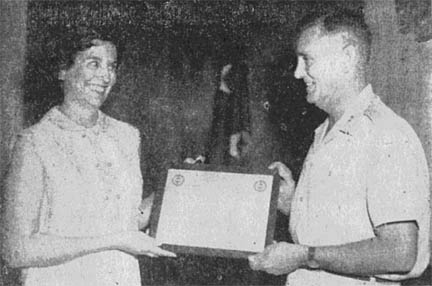 |
|
AT SCHOFIELD - Mrs. Arline Lora Weyand, wife of Maj. Gen. Fred C. Weyand,
division commander, is presented a certificate of achievement by Maj. Gen. Carl
Darnell Jr., commander, U.S. Army, Hawaii.. Mrs. Weyand was presented the award for her work in inspiring the women of Schofield Barracks to accomplish many worthwhile community service projects and to participate in numerous volunteer service programs. Mrs. Weyand's endorsement of, and participation in, the Army community service program served as a stabilizing influence for the thousands of wives left behind when the division moved to Vietnam. Through her guidance and encouragement, the participation in dependent education and training courses has been high. (Photo by USARHAW) |
| The TROPIC LIGHTNING NEWS is an
authorized publication of the 25th Infantry Division. It is published
weekly for all division units in the Republic of Vietnam by the
Information Office, 25th Infantry Division, APO U.S. Forces 96225. Army
News Features, Army Photo Features and Armed Forces Press Service material
are used. Views and opinions expressed are not necessarily those of the
Department of the Army. Printed in Saigon, Vietnam, by Dai Doan Ket
Publishing Company. Maj. Gen. Fred C. Weyand . . . . Commanding General Maj. William C. Shepard . . . . . . Information Officer 2nd Lt. Patrick J. McKeand . . . Officer-in-Charge Sp5 Dale P. Kemery . . . . . . . . . Editor PFC David L. Kleinberg . . . . . . Editorial Assistant |
Page 3 TROPIC LIGHTNING NEWS July 1, 1966
Division First
2/27th, 1/5th Join In Night Air Move
A warm Vietnamese night. Sloshing through smelling rice paddies. The
endless wait. The frustration.
It was the division's first night airmobile operation, conducted as part of
Operation "Fresno," which had been launched several days before.
The 2nd Battalion, 27th Infantry, was to set up nine ambush positions 13
miles northwest of Cu Chi. The 1st Battalion (Mechanized), 5th Infantry,
manning its armored personnel carriers, would then push a suspected battalion of
Viet Cong into the "Wolfhounds."
For Company A, 2/27th Inf., it was a night laced first with tension and then
with frustration. Scheduled to set up an ambush about four miles from their
command post, the men anxiously awaited their heli-lift as the sun dipped below
the horizon.
The drone of the choppers got the Wolfhounds to their feet and moving.
Within five minutes, the helicopters hovered over landing zone (LZ) Red, where
Co. A jumped into the rice paddies and ran for cover against enemy fire.
After long minutes of waiting in the fetid, knee-deep water of the paddy, the
men were convinced they would meet no resistance at the LZ.
The company plowed through the rice paddies for an uneventful half hour
before sniper fire ripped into the darkness.
As suddenly as it came, the fire from the invisible enemy stopped. The wet,
muddy troops picked themselves out of the paddy and began moving again.
Arriving at the ambush position, they waited for the VC. It was a long and
fruitless night. At 6:30 a.m., they started the one-and-a-half hour journey
back to the command post, where reports similar to theirs came flowing in. No
contact.
Why the VC battalion that was reported working in the area chose not to make
contact remains unknown. But there will be other nights.
'Chieu Hoi' Brand
Charlie Would Rather Switch Than Fight
Charlie! Charlie! Wouldn't you rather switch than fight? That's the
message, almost in so many words, that has been delivered to the Viet Cong and
their sympathizers since the Chieu Hoi - or open-arms program - started, in
April of 1963.
Now, the program that once occupied one office in the Vietnamese Ministry of
Information has spread into every district of the nation's 45 provinces. It
promises not only to help end communist influence in Vietnam, but to help many
Vietnamese families to a better way of life.
The program also has arrived at Cu Chi. Through the civil affairs office,
the division has distributed millions of leaflets describing the advantages of
the government and telling the VC to come home to their families.
The Chieu Hoi Program is aimed especially at influencing the Viet Cong and
their sympathizers to return to the cause of the government. It also attempts
to educate citizens with possible anti-government sentiments in the policies and
plans for the future of the Vietnamese government, including the nation's fight
against the communist influence now plaguing the country.
Through the use of military civic action programs, the Chieu Hoi offices and
the millions of open arms leaflets dropped across the Vietnamese countryside,
the benefits of the Chieu Hoi program are made known to every element of the
population.
It's dangerous for a Viet Cong to be caught reading the leaflets dropped by
American aircraft. If discovered as a possible defector, he could be killed by
the VC cadres. If he succeeds in escaping, however, he can be sure of a better
life.
After 20 to 45 days of instruction in a Chieu Hoi center, where he receives
200 piastres per month, a returnee may decide to join government forces or
return to family life. He may go back to his old village or to a New Life
Hamlet, where he and his family receive 3,000 to 3,500 piastres for a new home.
The man is also given 24 piastres a day for his food. If he is married, he
receives another 24 piastres for his wife and 12 for each child. A returnee
also receives 200 piastres pocket money for himself and 100 for his wife.
Many of the offices, like the one in Cu Chi, run by Nguyen Van Cong, employ
former VC who are trusted by the village program chief. The rehabilitated VC
are sent to the smaller villages in the district to try to win the people's
loyalty.
More than 13,000 VC have rallied to the government cause since the start of
this year. In Cu Chi alone so far in 1966, 51 ex-Viet Cong have stopped
fighting and switched.
Accident Rate Down In Division
Specialist Four David Perrin is a stocky, young man with very broad
shoulders, a requirement for his job of keeping the division base camp safe.
Twenty-three-year-old Perrin, a New York City native, is generally more safety
conscious in Vietnam than in Hawaii, but, he laments, the accident rate is still
very high.
"Motor vehicle accidents are on the decline because drivers realize that road
conditions in Vietnam are very bad and therefore exercise extra caution," says
Perrin. The big problem now is with small arms.
"When a soldier gets too familiar with his weapon, he gets careless, causing
mistakes. A soldier just can't be reminded often enough of the basic rules of
fire arms safety," Perrin says.
Another source of anguish to the young safety specialist is the growing
number of accidental burns that are reported. Immersion heaters used for
heating water and fire-operated cooking units are both fueled with gasoline.
Careless refueling and lighting of this type equipment can easily cause a
gasoline explosion, resulting in possibly fatal burns.
"If everybody in the camp could be watched," commented Perrin, "and reminded
to be careful, this kind of thing could be cut by 75 per cent."
"But that's something everyone has to do himself. I wish people would
realize that."
"You know, it's one thing to die for your country in battle, but to die from
an accident that could have been avoided is just plain senseless."
Close Call
Somebody out there didn't like him but as Sergeant Robert D. Smith of
Rockford, Ill., a fire team leader for Company A, 4th Battalion, 9th Infantry,
said afterwards "somebody up there did."
The somebody out there was a lone sniper in a wood line who opened fire on
Company A's third patrol during a search-and-destroy operation northwest of
Trang Bang.
Sergeant Smith hit the ground when the sniper opened up, aimed his M-16 and
then saw, to his astonishment, a gaping hole in the hand guard.
The sniper's round had gone completely through the rifle, missing his hand by
inches.
|
Viet VIP |
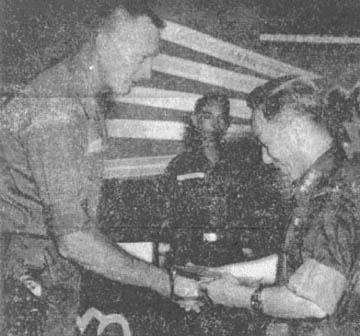 |
| BEARING GIFTS - Major General Fred C. Weyand, division commander, and Lieutenant General Nguyen Van Thieu, chairman of the National Leadership Committee of Vietnam, exchange gifts during a recent meeting at Cu Chi. (Photo by Park) |
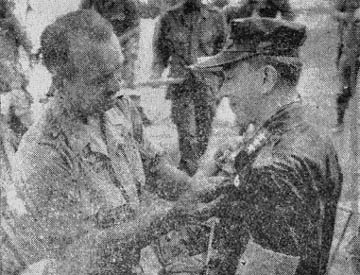 |
| Lieutenant Colonel Boyd T. Bashore, commanding officer, 2nd Battalion, 27th Infantry, presents an honorary "Wolfhound" pin on Lieutenant General Nguyen Van Thieu. (Photo by Hirsh) |
1/27th Finds Dead End After Long Search
Looking for one hamlet that contains a Viet Cong hospital among all the
little hamlets in Hau Nghia Province is like looking for a surgical needle in a
bandage pile.
When Company C, 1st Battalion, 27th Infantry, received such a task, they
began amassing information that sounded like clues in a detective novel.
The people in the nearby hamlet repeated rumors of a place where VC wounded
in that area were taken. Aerial photos, taken four miles from the "Wolfhound"
command post, showed a small hamlet that was arranged differently from any other
in the area.
Armed with such minimum information, Co. C started the wet and muddy march,
weathering a steady stream of enemy sniper fire as they drew closer to the
hamlet.
More intensive fire greeted the company as it approached the hamlet.
Thinking they had hit something big, the men pushed into the settlement.
After two hours of intensive searching, however, they had found nothing but a
small house with six extra beds and some bandage material. It could have been
an aid station but it was hardly the hospital.
Late in the afternoon, Co. C made its way back, with the mystery still
unsolved. Said one Wolfhound, "There was something out there, and we'll find it
next time."
4/9th Boasts Musical Mail
It wasn't going "tick, tick, tick," so it couldn't have been a bomb, but a
strange sound was coming from a mail bag at Company B, 4th Battalion, 9th
Infantry "Manchus."
As the mail was sorted, Vietnamese music could be heard, although no one
could locate the source until PFC Glenn J. Simmons, of Alto, Ga., stepped
forward to claim his mail that night.
Opening his package, he found a 12-transistor radio going full blast,
unmistakably on a Vietnamese frequency. The radio, a gift to the rifleman from
his mother, apparently was turned on in transit and coincidentally tuned to a
Vietnamese station.
Page 4 - 5 TROPIC LIGHTNING NEWS July 1, 1966
|
Photos by Sp4 James Pardue & PFC Jere Richardson |
Page 6 TROPIC LIGHTNING NEWS July 1, 1966
Smiles at Phuoc Hiep
Surgery Saves MEDCAP
As Captain James R. Murphy, of Birmingham, Mich., led his men into the
village he saw little to encourage him. There were no arms waving. There were
no smiles.
But the Medical Civic Action Program (MEDCAP) team ignored the cold
reception.
With the help of his medics, Capt. Murphy, battalion surgeon for 4th
Battalion, 9th Infantry, set up a small clinic at the local police headquarters
in the little village of Phuoc Hiep and prepared for business.
The first to come for aid was a stooped, old man, whose skin was wrinkled and
drawn. Sitting on a crude table, he told Capt. Murphy what was wrong through an
interpreter. The old man had been shot, and the bullet was lodged under his
left arm. Capt. Murphy delicately probed the area, finding the bullet near the
man's rib cage.
"An operation would be tricky and dangerous," said the captain.
If the bullet had pierced the lung the man might not live through surgery.
The man's age, plus the degree of infection, weighed heavily against success.
On the other hand, unless the bullet was removed he might die anyway.
The tools Capt. Murphy carried were basic: a scalpel, sutures, gauze and
hypodermic needles. After considerable thought, he decided the bullet should
come out.
Specialist Five George. R. Ballard, a clinical supervisor from Kinston, Ala.,
and PFC Max L. Mader, a medic from New Weston, Ohio, prepared the patient for the
operation while Capt. Murphy sterilized his instruments and washed.
The old man winced as a local anesthetic was administered, then sat
motionless. Capt. Murphy probed the area with his fingers, locating the slug.
Slowly and cautiously he started to cut, seeing the extent of the infection
around the bullet.
By this time villagers were gathering around the doctor, pushing for a better
look, talking in whispers, wondering what the strange American was doing. They
had never seen this before. Modern medicine was new to them.
Perspiration beaded on the medics' bodies. Cutting, feeling, cutting some
more. The scalpel ran across something hard. The tip of the bullet! Capt.
Murphy cut twice more. There. He laid the projectile in the victim's hand.
After the wound had been closed, the patient left the table and went through the
village holding the bullet over his head for all to see.
The ice had been broken for the MEDCAP team. People began coming from
everywhere. Capt. Murphy, Ballard, and Mader spent the rest of the day treating
the many patients who had lined up outside after the successful operation.
When the team left, instead of blank faces, they encountered smiles, waves,
and the cry of "Number one."
| RUB-A-DUB-DUB - Specialist Five Gerald L. Snyder. of Walla Walla, Wash., gives a Vietnamese boy a bath during a recent operation. Snyder is a medic with 2nd Battalion, 27th Infantry. (Photo by Hirsh) |
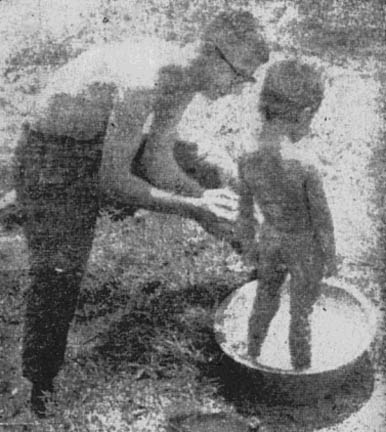 |
More to Come
Big Celebration for 'New Life Hamlet'
The tall captain with the green beret stepped up to the microphone and began
to speak. Throughout the crowd smiles and grins broke the features of the
children, adults and elders of the "New Life Hamlet" of Ben Vang.
Captain John W. Dargle was speaking Vietnamese, much to the surprise of the
crowd assembled for the dedication of this rural settlement.
The reason for the recent celebration was the creation of Ben Vang and Khiem
Hanh District in Tay Ninh Province.
As division and Army of the Republic of Vietnam (ARVN) forces moved through
Hau Nghia and Tay Ninh Provinces in recent months, Viet Cong terrorist tactics
drove many peasants to seek government protection.
Captain Dargle, of Cazenovia, N.Y., and his Special Forces "A" Team, advisors
to Khiem Hanh District, undertook the project of settling some 175 families with
more than 270 children.
Directing the project was Captain Nguyen Van Mach, Khiem Hanh district
chief. Under his supervision, and with the support of Lieutenant Colonel Ho Duc
Trung, Tay Ninh province chief, the new settlers and Regional and Popular Force
troops set about creating a new village.
With materials secured from the U.S. Association for International
Development through the efforts of Captain Dargle and his men, a new school
began to take shape.
By the middle of June, less than two months after beginning, the school and a
hamlet office were completed.
Last week, the joint efforts of the people, government and U.S. forces were
recognized by the official dedication of Ben Vang.
Following a ribbon-cutting ceremony, Col. Trung congratulated the villagers
on their efforts and welcomed them to the protection of the government.
Following an address by Captain Mach, Captain Dargle said, "A month ago we
asked you if you wanted a school for your children. You said yes. Today that
school is here..."
He also assured the people that government and U.S. help didn't end with the
construction of the school.
"If the VC come to your village and take your money and rice, tell us, and
the American and ARVN forces will drive them out..." he said.
Though a dedication usually signals the end of a project, Captain Dargle's
work had just begun in Khiem Hanh District. Three more New Life hamlets are on
the planning boards and a refugee center at the district seat of Ben Don has
just been completed.
But Captain Dargle isn't the only American concerned about the people of
Khiem Hanh. The division's 2nd Brigade is represented by Major Robert C. Gutner,
of Atlantic City, N. J., the brigade S-5, has donated rice and clothing to help
the settlers of Ben Vang.
One of the primary tactics in the U.S. second mission is to help the people
to help themselves.
Soup, Nuts, Potatoes
What They Talk About In 2/35th Bunkers
Each night at every military camp in Vietnam soldiers man the defensive
perimeters. Silent, watchful men, they wait in guard bunkers to take their turns on the perimeter
- some sleeping, some reading, some talking. What do they talk about? The
topics range from, as the expression goes, soup to nuts.
And the men of Company C, 2nd Battalion, 35th Infantry, are great talkers.
Although soup was not discussed, mashed potatoes were. One of the men in the
bunker worked as a cook, and the others wanted to know who was responsible for
preparing the mashed potatoes.
The cook shrugged off the responsibility, but said that he'd ask the man who
did fix the potatoes to put in more salt.
Nuts, per se, were not brought up either, except in reference to the exploits
of some fellow members of the company. These exploits included capers in the
States as well as those on the battlefield.
There was the inevitable talk about what each man was going to do when he got
back to the States after his tour in Vietnam. Everyone mentioned how great his
girl friend was or, in the case of married men, how great their wives and
children, were. One man couldn't wait to return to see his new son, born
shortly after he arrived in Vietnam.
Some talked about the new car they would buy after returning home.
Outside the bunker, not far away, small arms fire was heard. "Joe's on the
line tonight, probably got another shadow," one of them said. "Who did you say
makes the mashed potatoes?"
U.S., Filipinos in MEDCAP
Two 25th Infantry Division battalion surgeons and a Filipino civic assistance
team worked together in a recent Medical Civic Action Program (MEDCAP) visit in
the village of Bao Trai.
Captains John B. Thompson, South Bend, Ind., and Robert C. Allin, Chicago,
Ill., battalion surgeons for 1st Battalion, 8th Artillery, and 2nd Battalion,
32nd Artillery, aided a six-man Filipino medical team, which conducts a daily
sick call in the Bao Trai dispensary.
Both artillery units were engaged in Operation "Santa Fe" when the MEDCAP was
conducted. They treated 54 patients.
How Air Force, Division Team Up
Trying to rid Vietnam of the Viet Cong is a team effort. Two members of this
team are the division and the U.S. Air Force.
No one element can fight the Viet Cong by itself and that's where teamwork
comes in. But making the teams work together requires both members of the team
to be at the right place at the right time.
Bringing the two together is the job of Lieutenant Colonel Henry A. Jones,
48, of Shawnee, Okla., the Air Force liaison officer attached to the division.
He is the man who coordinates the operations of the "Tropic Lightning"
Division and elements of the Air Force and Naval Aviation.
Col. Jones' staff consists of five officers and eight enlisted men at each
brigade and four officers and ten enlisted men at the division. They must keep
information flowing into the liaison officer so that all the help needed reaches
"Tropic Lightning' soldiers on time.
When a division unit calls for air support it must often come a long
distance. Thanks to Col. Jones and his men, it not only arrives when needed but
it is right on target.
Women's Club Sends Cookies
Wounded soldiers at the division field hospital are eating homemade cookies
today. They are just like mom used to make but they didn't come from mom.
When Sergeant First Class Thomas Brito, of Bridgeport, Conn., wrote to his
wife, Laura, and thanked her for the "goody box" she had sent him, she took the
letter to the Cape Verdean Women's Club and showed it to some of the other
members. They decided there may be many soldiers in Vietnam who would
appreciate something from home and their project began.
The women, all of Portuguese descent, collected toothpaste, shaving cream,
after-shave lotion, candy and cookies, and many other items they thought the
soldiers might like. The first four of several boxes arrived at Cu Chi last
Saturday.
Sgt. Brito took the gift packages to the hospital and passed them around to
the surprised troops.
"It's just like Christmas," said one soldier. "I think I'll get shot more
often."
"I haven't tasted cookies like these in six months," said another through a
mouthful.
The boxes were passed from bed to bed and the men shared the gifts as they
had shared their C-rations, water and cigarettes in the field. Sgt. Brito
slipped out and returned to Troop A, 3rd Squadron,4th Cavalry, where he resumed
his duties as a platoon sergeant.
Page 7 TROPIC LIGHTNING NEWS July 1, 1966
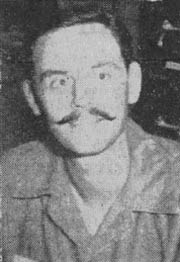 |
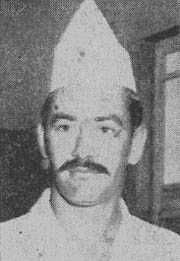 |
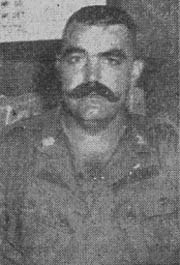 |
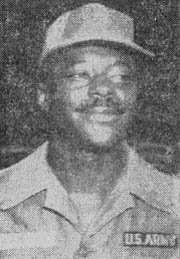 |
| AMATEUR - Specialist Four Thomas C e, stenographer for the division G-1 section, displays the first mustache he has grown. | PROFESSIONAL - Specialist Four Huey Johnson, first cook for the general's mess, says he has grown a mustache many times. | WILD - Major Edward McManus, assistant division G-1, sports a handlebar mustache. | TAME - Master Sergeant Sterling J. Brown, intelligence sergeant for 3rd Battalion 13th Artillery, wears his mustache in a military trim. |
The Longs And Shorts
Throughout history the mustache has retained a prominent place beneath the
noses of many of the world's greatest men. Like all fashions, it has had its
longs and shorts.
The popularity of the mustache in America has been on the decline for many
years, but the war in Vietnam may be just the stimulus needed to bring it back.
In the 1800's a mustache was the sign of a combat veteran and new recruits
were not allowed to grow them until they had seen battle. Today, many of the
soldiers in the division, after only a few months in Vietnam, have begun to
follow the style of their Army forerunners.
There is Major Edward McManus, 36, of Newport, R.I., assistant division G-1,
who says he has grown a mustache every time he has had overseas duty - first in
Korea, then Alaska and now Vietnam.
Sergeant First Class Willie Brooks, 37, of Jackson, Tenn., Headquarters
Battery, 3rd Battalion, 13th Artillery, reports that he wears a mustache because
"It adds a little distinction."
When asked why he wears a mustache, Major George W. Witcomb, 36, of Denver,
Colo., operations officer for the 3/13th Arty., asked, "Why not?"
Specialist Four Thomas A. Cue, of Pittsburgh, Pa., a stenographer for the
G-1, said he grew one because he never had one before. A fellow Pennsylvanian,
Master Sergeant Sterling J. Brown, 33, of Philadelphia, intelligence sergeant
for 3/13th Arty., says he wears a mustache because he has "always worn one."
Specialist Four Huey Johnson, 22, of Douglas, Ga., first cook at the
general's mess, says he has grown one many times during his life. "Some people
raise dogs, some people raise chickens; I raise mustaches."
Since the Army regulations regarding mustaches are listed under sanitation,
Captain T. J. Tomkiewicz, of Reading Pa., surgeon for 3/13th Arty, was consulted
and he reported that "as long as they are shampooed regularly and are not
allowed to droop in one's soup, mustaches are in no way hazardous to health."
Fear of Reprisal
Boy Uncovers V.C. Minefield, Tells GIs
Nguyen Van Nhan is a young boy who lives in a small, Vietnamese hamlet with
his mother and three younger brothers, but soon he and his family must leave the
hamlet where he was born to escape the wrath of the Viet Cong.
The day that changed Nhan's life began, like any other day, with some games
in a nearby field with his younger brother. But this was neither another game in
the field nor just another day because Van Nhan and his brother had
inadvertently discovered a Viet Cong minefield.
Nhan ran carefully through the field to the road where a Jeep, with three
American soldiers and a Vietnamese policeman, was driving by. Van Nhan stopped
the Jeep and excitedly related his find to the soldiers, who called a demolition
team of the 1st Battalion, 27th Infantry, to clear the field. The division
soldiers carefully went to work.
The team found 22 grenades, one booby-trapped grenade, 16 60mm mortar round
duds and two 155mm howitzer duds. After two hours of hot, exacting work, the
field was cleared, and the demolition experts relaxed. One of the men asked Van
Nhan, with the help of the policeman, what he would do when the VC found out
that he had helped the Americans.
The young boy looked up with an unworried smile on his face and said he and
his family would have to move out of the area as soon as the Americans left so
that the VC would not kill him or any of his family.
The soldiers glanced at one another in silence, perhaps thinking of what they
would do if they had to leave most of what they owned and move to a strange
place.
They looked like eighth graders trying to understand their first French
lesson as they listened to the policeman ask Nhan what he wanted for a reward.
But the perplexed expressions broke into smiles as the answer was translated
"American C-rations, please."
QM Doesn't Close Or Doze
In the middle of a rice paddy just southwest of Pleiku there is a sign that
reads, "We may doze, but we never close." The other day the laundry personnel
were thinking of changing their sign to read, "We may close, but we'll never
doze."
The sign hangs in front of the field laundry run by the 526th Quartermaster
Company for the 3rd Brigade Task Force.
On an average day the laundry handles a ton of clothes. It comes to them in
a bulk load, is separated into types of clothing, and then counted piece by
piece. It was during the counting process that they almost said goodbye to
their suds forever.
PFC Anthony Rick, one of 18 men who work in the laundry, was counting
trousers when a grenade fell out of a pocket. Not knowing if the pin was out of
it, he headed away from the grenade at full speed. Another man just stood
there, too startled to move. Luckily, the pin was still in it and nothing
happened.
Since the grenade incident, the sign is still standing but there haven't been
any laundry personnel seen dozing.
|
The Irascible Python |
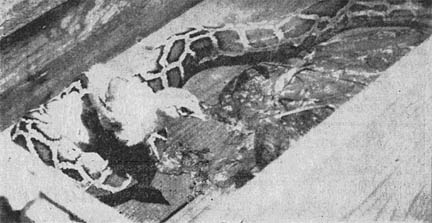 |
| PYTHON LUNCH - A six-foot python prepares his lunch of three baby chicks. Captain Melvin A. Casberg, division Headquarters Company surgeon, is minding the snake while its owner is on a field operation near Cu Chi. (Photo by Hirsh) |
He Bites, Hisses And Eats
It had been more than three weeks and Captain Melvin A. Casberg Jr., of
Belmont Shores, Calif., was still waiting for a unit to return from a division
operation.
Capt. Casberg, surgeon for Headquarters Company, 25th Division, plainly
admitted that he was tired of babysitting for a recalcitrant, cantankerous,
irascible, six-foot long python.
The lengthy snake was presented to the doctor by a friend just before the
unit left, and while he doesn't know whether his boxed-in snake was purchased or
captured, he does know that it has caused him some trouble.
"It's been hissing at me and it bit me twice," the doctor complained. "We
haven't been harassing it. I think he's been eating too much."
The python, which has no venom in its fangs and kills by squeezing its prey,
eats about once every ten days - and that's usually enough.
"He eats an enormous amount of food," Capt. Casberg confessed, "In fact, he
doesn't know when to stop. We fed him five baby chicks last time, but I think
that was too much."
The captain suspects part of the snake's recent irritability can be
pinpointed to its shedding skin.
In any case, he thought briefly of giving the python some tranquilizers, but
rejected the idea. "In cold-blooded animals you don't know the effects of
certain drugs. It might have killed him."
Capt. Casberg found the solution: there are now only three baby chicks on the
python's dinner menu.
Page 8 TROPIC LIGHTNING NEWS July 1, 1966
| Vietnam Communique... A weekly summary of major Army actions in the Republic of Vietnam compiled by Army News Features from Department of Defense published Official MACV Communiques. June 16 through June 22, 1966 1st Cavalry Division (Airmobile) - Heavy contacts with the enemy on June 21
and 22 were reported by units of the 3rd Brigade reinforcing elements of the
101st Airborne Division in the new operation "Nathan Hale." (See 101st Airborne
Division account.) |
'Good Job' - CG
Downed Chopper Saved From Marauding Cong
"An outstanding job," said Major General Fred C. Weyand, division commander,
in commending 2nd Lieutenant John F. Alto, of Seaside, Ore.
The pat on the back came after Lt. Alto's unit, the aero rifle platoon in 3rd
Squadron, 4th Cavalry, rescued a downed helicopter 25 miles northwest of Saigon
near the Iron Triangle.
The mission started when a CH-47 (Chinook) helicopter, on a reconnaissance
mission, took a round of enemy fire in its oil system and was forced to land in
a clearing in Viet Cong territory.
The rescue job was given to the men of the aero rifle platoon, a unit
experienced in rescue under fire. Forty minutes later, four choppers from D
Troop, 3/4 Cav., had airlifted 30 men of the platoon to secure the area.
Meanwhile, the original distress call brought Air Force jets in to pound
nearby enemy positions with bombs and napalm.
Gun ships from D Trp. supplied protection from the air in shifts as they
machine-gunned the VC that were closing in on the crippled ship.
Parts were called for from Saigon, and rescue choppers evacuated the
passenger's of the Chinook to Cu Chi.
During the afternoon, the platoon was resupplied with ammunition to sustain
their harassing fire, keeping the enemy away from the area.
By five o'clock, the new parts were in place and fresh oil added to replace
that which had sprayed the interior and passengers. The big ship was given a
final check before it lifted to fly again another day.
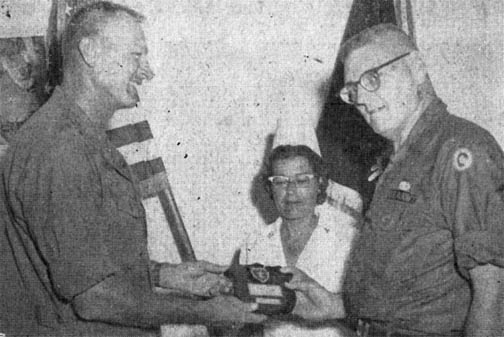 |
THANKS - Major General Fred C. Weyand, division commander (l.), presents Lieutenant Colonel Joseph E. Malloy, commander of 3rd Field Hospital, with a division plaque, expressing "Tropic Lightning" appreciation for the medical help given to the division's wounded. Looking on is Major Catherine T. Betz, 3rd Field chief nurse. |
Hawaii Excluded In Vietnam R&R Quotas for July
Hawaii does not appear on the rest and recuperation (R and R) quotas for July
but it may be included in the August quotas, the division Special Services has
announced.
Department of Defense officials recently designated Hawaii as an R and R
center on a trial basis.
Presently there are eight authorized R and R sites - Tokyo, Japan; Taipei,
Taiwan; Manila, Philippines; Singapore; Kuala Lumpur, Malaysia, and the
little-known isle of Penang, Malaysia.
In-country R and R is limited to Vung Tau.
'Times' Contest Solicits Soldier Photog Entries
Army Times Publishing Company has announced a "combat photographers"
photography contest for American servicemen in Vietnam.
Tony March, editor of Army Times, says the publication is interested in
photography produced by "the U.S. soldier who goes into battle with his combat
gear and camera slung over his shoulder."
March scored the inability of civilian photographers to be always on the spot
whenever and wherever contact is made with the enemy; or at the precise moment
when a soldier is heroically aiding his wounded buddy."
Army Times is offering cash prizes, which have not yet been announced, to be
awarded periodically to first, second and third place winners selected by a
contest panel.
Rules specify that all entries should be printed on glossy paper in eight by
ten-inch, five by seven-inch or four by five-inch sizes. They must be
completely captioned.
All entries should be addressed to Army Times Publishing Company, 2201 M
Street, N.W. , Washington, D.C. 20037.
Finance Writes Off Problems
The Army's finance office at Cu Chi couldn't bring along its 20th century
computers but, along with its other jobs, it still manages to meet the monthly
payroll.
Major Dwight L. Groninger, of Akron, Ind., division finance officer, heads
the staff of 38 enlisted men and two officers at the Cu Chi branch and the
"Class B" office at Pleiku.
They make sure that several million dollars each month gets to the men and
their dependents back home, to say nothing of processing travel vouchers,
providing currency exchange and sale of Treasury checks.
While the men in the Cu Chi office don't enjoy the comforts of their civilian
counterparts, they manage to overcome their handicaps in checking and
re-checking the thousands of tabulations that go into a monthly payroll.
Operating from two large tents and one semi-trailer van, which houses some of
the more complex accounting machines, the finance clerks, working closely with
personnel teams from 25th Administration Company, process the stacks of
vouchers, which reach eight inches high for one company alone.
Major James C. Gordon Jr., of Jacksonville, Fla., deputy finance officer,
recalled that when the 2nd Brigade arrived late in January, it wasn't unusual
for sniper bullets to tear through the tents. Complicating things was the
choking dust, which damaged half of the section's adding machines.
The major recounted that one, big storm blew down three of the office's four
tents and pay vouchers ended up in the mud five days before payday.
No matter. The men were still paid.
Thanks to:
The 25th Infantry Division Museum for providing the volume of 1966 Tropic
Lightning News,
Ron Leonard, 25th Aviation Battalion for finding and mailing them,
Kirk Ramsey, 2nd Bn., 14th Inf. for creating this page.
This page last modified 10-27-2006
©2006 25th Infantry Division Association. All rights reserved.